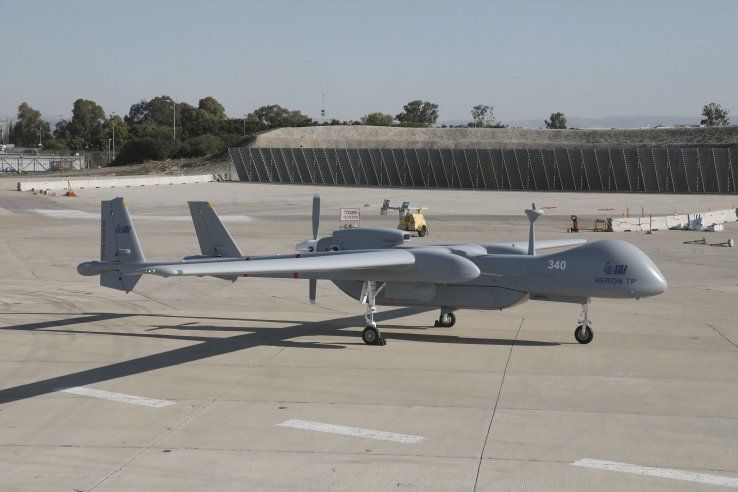India has received the delivery of an advanced Israeli drone, Heron TP, as part of a deal signed earlier this year. The Heron TP unmanned aerial vehicles (UAVs) are likely to be deployed for “long surveillance missions” along the Line of Actual Control (LAC), the disputed border between India and China.
“The advanced Heron drones have arrived in the country and are being deployed for surveillance operations in the eastern Ladakh sector,” people familiar with the development told ANI on November 30.
Reports suggest that these new UAVs are far more advanced than the existing inventory in terms of anti-jamming capability. The deal was announced in February this year, for the lease of four Heron-TP drones for 3 years under the new Defense Acquisition Procedure (DAP) 2020.

While the initial plan was to lease the drones, New Delhi later decided to buy them instead, and move forward with its ‘Project Cheetah’ to arm these drones with lethal air-to-ground guided munitions.
This was done under emergency procurement provisions in the new DAP. The emergency route has been used extensively by the Indian military in the backdrop of the continuing dispute, with the HAMMER missiles being a more recent example.
Under the same rules, the Indian Navy had leased two MQ-9B Sea Guardian UAVs from the United States last year to bolster its maritime surveillance capabilities.
The Ladakh standoff has entered its second winter and the two militaries are staying put at the friction points with additional deployment being made in the eastern sector (Arunachal Pradesh ) as well.
#Watch | #Israel has delivered India its advanced #Heron drones, which will be deployed in #Ladakh where India and #China are locked in a bitter standoff.@adgpi pic.twitter.com/52GFUyMjrz
— Hindustan Times (@htTweets) November 30, 2021
On November 18, India and China agreed to conduct the 14th round of military-level talks to negotiate disengagement from the remaining friction points, however, no tentative date was announced. The last round of talks resulted in no major conclusions with the Chinese remaining non-committal on the complete disengagement that was evident in their communiqué.
To keep a hawk’s eye on Chinese activities in the region, the Indian Army has now received ‘more advanced versions of Israeli Heron UAV’, and the same would be deployed to eastern Ladakh.
Significant efforts have been made to ramp up Intelligence, Reconnaissance and Surveillance (IRS) operations along the border. Additionally, Boeing 8I Neptune anti-submarine warfare aircraft from the Indian Navy has also been deployed to eastern Ladakh to conduct reconnaissance along the LAC, as previously reported by the EuraAsian Times.
The rapid Chinese troop development and the unpredictability of their movement warrant the Indian side to constantly monitor the borders.
The Heron-TP Deal With India
Developed by Israel Aerospace Industrie (IAI), the Heron-TP, is an upgrade from the existing Heron UAVs, expanding its versatility as a platform to cater to the demands of international customers.
It can perform surveillance, target acquisition, intelligence gathering and with some modifications; even strike capability can be added. The Heron-TP can accommodate a variety of sensors and payloads according to mission requirements.
The new Heron has been exported to countries including Greece and Germany. However, its original variant has been much more successful, which is being operated by more than 10 countries.
#IndianArmy receives new #Israeli Heron drones for deployment in #Ladakh sector https://t.co/f0s6uN3NHA pic.twitter.com/wJn4esvrPA
— Indian Military News (@indmilitarynews) November 30, 2021
The IAI Heron TP has the same length as the Rafale fighter — 14 meters — and its wingspan is double the French aircraft. It’s a Medium Altitude Long Endurance (MALE) drone for all-weather strategic missions. While the Heron TP drones can be armed if necessary, India is leasing non-weaponized versions.
For a longer range, the Heron TP drones have automated taxi-takeoff and landing (ATOL) and satellite communication (SATCOM) systems. The drones will be equipped with ultra-long-range surveillance cameras as well as other cutting-edge technology, as previously reported by Economic Times.
The defense ministry also earlier finalized a proposal to upgrade approximately 80-90 Heron drones used by the Army, Navy, and Indian Air Force. In addition, India will buy roughly 30 multi-mission armed MQ-9 Predator-B drones from the US for the three services at a cost of $3 billion.
- Authored By Ayush Jain and Sakshi Tiwari
- Email: etdesk@eurasiantimes.com
- Follow EurAsian Times on Google News




